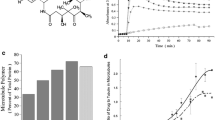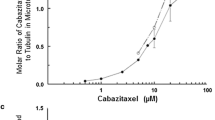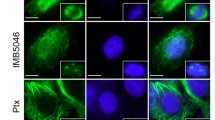Summary
The subunit protein of microtubules is tubulin, which has been the target for some of the most successful and widely used anti-tumor drugs. Most of the drugs that target tubulin bind to the β subunit. There are many isotypes of β-tubulin and their distributions differ among different tissues. The βIII isotype is over-expressed in many tumors, particularly those that are aggressive, metastatic, and drug resistant. We have previously reported the design and synthesis of a series of compounds to fit the colchicine site on βIII but not on the other isotypes. In the current study, we tested the toxicity and the anti-tumor activity of one of these compounds, CH-35, on the human breast tumor MDA-MB-231 over-expressing βIII in a xenogeneic mouse model. We found that CH-35 was as toxic as Taxol® in vivo. Although the βIII-over-expressing cells developed into very fast-growing tumors, CH-35 was more effective against this tumor than was Taxol. Our results suggest that CH-35 is a promising candidate for future drug development.








Similar content being viewed by others
References
Sartorelli AC, Creasey WA (1969) Cancer chemotherapy. Ann Rev Pharmacol 9:51–72
Goldspiel BR (1997) Clinical overview of the taxanes. Pharmacotherapy 17:110S–125S
Goodman LS, Hardman JG, Limbird LE, Gilman AG (2001) Goodman and Gilman’s the pharmacological basis of therapeutics, 10th edn. McGraw-Hill Companies, NY
Nicolini A, Giardino R, Carpi A, Ferrari P, Anselmi L, Colosimo S, Conte M, Fini M, Giavaresi G, Berti P, Miccoli P (2006) Metastatic breast cancer: an updating. Biomed Pharmacother 60:548–556
Zhang J, Gu SY, Gan Y, Wang ZH, Wang BY, Guo HY, Wang JL, Wang LP, Zhao XM, Hu XC (2013) Vinorelbine and capecitabine in anthracycline- and/or taxane-pretreated metastatic breast cancer: sequential or combinational? Cancer Chemother Pharmacol 71:103–113
Dumontet C, Jordan MA, Lee FF (2009) Ixabepilone: targeting βIII-tubulin expression in taxane-resistant malignancies. Mol Cancer Ther 8:17–25
Ludueña RF (1998) Multiple forms of tubulin: different gene products and covalent modifications. Int Rev Cytol 178:207–275
Ludueña RF, Shooter EM, Wilson L (1977) Structure of the tubulin dimer. J Biol Chem 252:7006–7014
Lewis SA, Lee MG, Cowan NJ (1985) Five mouse tubulin isotypes and their regulated expression during development. J Cell Biol 101:852–861
Uppuluri S, Knipling L, Sackett DL, Wolff J (1993) Localization of the colchicine-binding site of tubulin. Proc Natl Acad Sci U S A 90:11598–11602
Rai SS, Wolff J (1996) Localization of the vinblastine-binding site on beta-tubulin. J Biol Chem 271:14707–14711
Rao S, He L, Chakravarty S, Ojima I, Orr GA, Horwitz SB (1999) Characterization of the taxol binding site on the microtubule. Identification of Arg(282) in beta-tubulin as the site of photoincorporation of a 7-benzophenone analogue of Taxol. J Biol Chem 274:37990–37994
Luduena RF (2013) A hypothesis on the origin and evolution of tubulin. Int Rev Cell Mol Biol 302:41–185
Banerjee A, Ludueña RF (1992) Kinetics of colchicine binding to purified β-tubulin isotypes from bovine brain. J Biol Chem 267:13335–13339
Derry WB, Wilson L, Khan IA, Ludueña RF, Jordan MA (1997) Taxol differentially modulates the dynamics of microtubules assembled from unfractionated and purified beta-tubulin isotypes. Biochemistry 36:3554–3562
Khan IA, Tomita I, Mizuhashi F, Luduena RF (2000) Differential interaction of tubulin isotypes with the antimitotic compound IKP-104. Biochemistry 39:9001–9009
Xu K, Schwarz PM, Ludueña RF (2002) The interaction of nocodazole with tubulin isotypes. Drug Deve Res 55:91–96
Khan IA, Ludueña RF (2003) Different effects of vinblastine on the polymerization of isotypically purified tubulins from bovine brain. Investig New Drugs 21:3–13
Yeh IT, Ludueña RF (2004) The βII isotype of tubulin is present in the cell nuclei of a variety of cancers. Cell Motil Cytoskeleton 57:96–106
Rowinsky EK, Eisenhauer EA, Chaudhry V, Arbuck SG, Donehower RC (1993) Clinical toxicities encountered with paclitaxel (Taxol). Semin Oncol 20:1–15
Pratt WB, Ruddon RW, Ensminger WD, Maybaum J (1994) The anticancer drugs, 2nd edn. Oxford University Press, NY, p 191
Wolf S, Barton D, Kottschade L, Grothey A, Loprinzi C (2008) Chemotherapy-induced peripheral neuropathy: prevention and treatment strategies. Eur J Cancer 44:1507–1515
Shalli K, Brown I, Heys SD, Schofield AC (2005) Alterations of beta-tubulin isotypes in breast cancer cells resistant to docetaxel. FASEB J 19:1299–1301
Leandro-García LJ, Leskelä S, Landa I, Montero-Conde C, Lópex-Jímenez E, Letón R, Cascón A, Robledo M, Rodríguez-Antona C (2010) Tumoral and tissue-specific expression of the major human β-tubulin isotypes. Cytoskeleton 67:214–223
Chao SK, Wang Y, Verdier-Pinard P, Yang CP, Liu L, Rodriguez-Gabin A, McDaid HM, Horwitz SB (2012) Characterization of a human βV-tubulin antibody and expression of this isotype in normal and malignant human tissue. Cytoskeleton 69:566–576
Christoph DC, Kasper S, Gauler TC, Loesch C, Engelhard M, Theegarten D, Poettgen C, Hepp R, Peglow A, Loewendick H, Welter S, Stamatis G, Hirsch FR, Schuler M, Eberhardt WE, Wohlschlaeger J (2012) βV-tubulin expression is associated with outcome following taxane-based chemotherapy in non-small cell lung cancer. Br J Cancer 107:823–830
Ferlini C, Raspaglio G, Cicchillitti L, Mozzetti S, Prislei S, Bartollino S, Scambia G (2007) Looking at drug resistance mechanisms for microtubule interacting drugs: does TUBB3 work? Curr Cancer Drug Targets 7:704–712
Burgoyne RD, Cambray-Deakin MA, Lewis SA, Sarkar S, Cowan NJ (1988) Differential distribution of β-tubulin isotypes in cerebellum. EMBO J 7:2311–2319
Lewis SA, Cowan NJ (1988) Complex regulation and functional versatility of mammalian alpha- and beta-tubulin isotypes during the differentiation of testis and muscle cells. J Cell Biol 106:2023–2033
Banerjee A, Roach MC, Wall KA, Lopata MA, Cleveland DW, Ludueña RF (1988) A monoclonal antibody against the type II isotype of beta-tubulin. Preparation of isotypically altered tubulin. J Biol Chem 263:3029–3034
Yvon AM, Wadsworth P, Jordan MA (1999) Taxol suppresses dynamics of individual microtubules in living human tumor cells. Mol Biol Cell 10:947–959
Drewes G, Ebneth A, Mandelkow EM (1998) MAPs, MARKs and microtubule dynamics. Trends Biochem Sci 23:307–311
Hasegawa S, Miyoshi Y, Egawa C, Ishitobi M, Taguchi T, Tamaki Y, Monden M, Noguchi S (2003) Prediction of response to docetaxel by quantitative analysis of class I and III beta-tubulin isotype mRNA expression in human breast cancers. Clin Cancer Res 9:2992–2997
Katsetos CD, Del Valle L, Geddes JF, Assimakopoulou M, Legido A, Boyd JC, Balin B, Parikh NA, Maraziotis T, de Chadarevian JP, Varakis JN, Matsas R, Spano A, Frankfurter A, Herman MM, Khalili K (2001) Aberrant localization of the neuronal class III β-tubulin in astrocytomas. A marker for anaplastic potential. Arch Pathol Lab Med 125:613–624
Katsetos CD, Del Valle L, Geddes JF, Aldape K, Boyd JC, Legido A, Khalili K, Perentes E, Mörk SJ (2002) Localization of the neuronal class III β-tubulin in oligodendrogliomas: comparison with Ki-67 proliferative index and 1p/19q status. J Neuropathol Exp Neurol 61:307–320
Katsetos CD, Herman MM, Mörk SJ (2003) Class III beta-tubulin in human development and cancer. Cell Motil Cytoskeleton 55:77–96
Katsetos CD, Legido A, Perentes E, Mörk SJ (2003) Class III β-tubulin isotype: a key cytoskeletal protein at the crossroads of developmental neurobiology and tumor neuropathology. J Child Neurol 18:851–866
Cicchillitti L, Penci R, Di Michele M, Filippetti F, Rotilio D, Donati MB, Scambia G, Ferlini C (2008) Proteomic characterization of cytoskeletal and mitochondrial class III β-tubulin. Mol Cancer Ther 7:2070–2079
Paradiso A, Mangia A, Chiriatti A, Tommasi S, Zito A, Latorre A, Schittulli F, Lorusso V (2005) Biomarkers predictive for clinical efficacy of taxol-based chemotherapy in advanced breast cancer. Ann Oncol 16(suppl 4):iv14-19
Tommasi S, Mangia A, Lacalamita R, Bellizzi A, Fedele V, Chiriatti A, Thomssen C, Kendzierski N, Latorre A, Lorusso V, Schittulli F, Zito F, Kavallaris M, Paradiso A (2007) Cytoskeleton and paclitaxel sensitivity in breast cancer: the role of beta-tubulins. Int J Cancer 120:2078–2085
Stengel C, Newman SP, Leese MP, Potter BV, Reed MJ, Purohit A (2010) Class III beta-tubulin expression and in vitro resistance to microtubule targeting agents. Br J Cancer 102:316–324
Gan PP, McCarroll JA, Po’uha ST, Kamath K, Jordan MA, Kavallaris M (2010) Microtubule dynamics, mitotic arrests, and apoptosis: drug-induced differential effects of βIII-tubulin. Mol Cancer Ther 9:1339–1348
McCarroll JA, Gan PP, Liu M, Kavallaris M (2010) βIII-tubulin is a multifunctional protein involved in drug sensitivity and tumorigenesis in non-small cell lung cancer. Cancer Res 70:4995–5003
Ploussard G, Terry S, Maillé P, Allory Y, Sirab N, Kheuang L, Soyeux P, Nicolaiew N, Coppolani E, Paule B, Salomon L, Culine S, Buttyan R, Vacherot F, de la Taille A (2010) Class III β-tubulin expression predicts prostate tumor aggressiveness and patient response to docetaxel-based chemotherapy. Cancer Res 70:9253–9264
Pentheroudakis G, Batistatou A, Kalogeras KT, Kronenwett R, Wirtz RM, Bournakis E, Eleftheraki AG, Pectasides D, Bobos M, Papaspirou I, Kamina S, Gogas H, Koutras AK, Pavlidis N, Fountzilas G (2011) Prognostic utility of β-tubulin isotype III and correlations with other molecular and clinicopathological variables in patients with early breast cancer: a translational Hellenic Cooperative Oncology Group (HeCOG) study. Breast Cancer Res Treat 127:179–193
Yuan SF, Zhu LJ, Zheng WE, Chen H, Wu LL, Zhang W, Sun HY, Chen WJ (2012) Expression of β-tubulin III and survivin in advance stage breast cancer correlates with chemotherapeutic effects of docetaxel. Asian Pac J Cancer Prev 13:361–365
Zhao HY, Huang H, Hu ZH, Huang Y, Lin SX, Tian Y, Lin TY (2012) Evaluations of biomarkers associated with sensitivity to 5-fluorouracil and taxanes for recurrent/advanced breast cancer patients treated with capecitabine-based first-line chemotherapy. Anticancer Drugs 23:534–542
Narvi E, Jaakkola K, Winsel S, Oetken-Lindholm C, Halonen P, Kallio L, Kallio MJ (2013) Altered TUBB3 expression contributes to the epothilone response of mitotic cells. Br J Cancer 108:82–90
Horak CE, Pusztai L, Xing G, Trifan OC, Saura C, Tseng LM, Chan S, Welcher R, Liu D (2013) Biomarker analysis of neoadjuvant doxorubicin/cyclophosphamide followed by ixabepilone or paclitaxel in early-stage breast cancer. Clin Cancer Res 19:1587–1595
Saussede-Aim J, Matera EL, Herveau S, Rouault JP, Ferlini C, Dumontet C (2009) Vinorelbine induces β3-tubulin gene expression through an AP-1 site. Anticancer Res 29:3003–3009
Saussede-Aim J, Matera EL, Ferlini C, Dumontet C (2009) β3-Tubulin is induced by estradiol in human breast carcinoma cells through an estrogen-receptor dependent pathway. Cell Motil Cytoskeleton 66:378–388
Gan PP, Pasquier E, Kavallaris M (2007) Class III beta-tubulin mediates sensitivity to chemotherapeutic drugs in non-small cell lung cancer. Cancer Res 67:9356–9363
Guo J, Walss-Bass C, Ludueña RF (2010) The beta isotypes of tubulin in neuronal differentiation. Cytoskeleton 67:431–441
Galmarini CM, Treilleux I, Cardoso F, Bernard-Marty C, Durbecq V, Gancberg D, Bissery MC, Paesmans M, Larsimont D, Piccart MJ, Di Leo A, Dumontet C (2008) Class III beta-tubulin isotype predicts response in advanced breast cancer patients randomly treated either with single-agent doxorubicin or docetaxel. Clin Cancer Res 14:4511–4516
Jung M, Koo JS, Moon YW, Park BW, Kim SI, Park S, Lee SH, Hong S, Rha SY, Chung HC, Kim JH, Sohn J (2012) Overexpression of class III beta tubulin and amplified HER2 gene product good response to paclitaxel and trastuzumab therapy. PLoS One 7, e45127
Wang Y, Sparano JA, Fineberg S, Stead L, Sunkara J, Horwitz SB, McDaid HM (2013) High expression of class III β-tubulin predicts good response to neoadjuvant taxane and doxorubicin/cyclophosphamide-based chemotherapy in estrogen receptor-negative breast cancer. Clin Breast Cancer 13:103–108
Ferlini C, Raspaglio G, Mozzetti S, Cicchillitti L, Filippetti F, Gallo D, Fattorusso C, Campiani G, Scambia S (2005) The seco-taxane IDN5390 is able to target class III β-tubulin and to overcome paclitaxel resistance. Cancer Res 65:2397–2405
Cianfrocca M (2008) Application of epothilones in breast cancer therapy. Curr Opin Oncol 20:634–638
Gupta D, Mani S (2009) The efficacy and safety of ixabepilone monotherapy in the treatment of breast and gynecologic malignancies. Expert Opin Drug Saf 8:81–88
Pepe A, Sun L, Zanardi I, Wu X, Ferlini C, Fontana G, Bombardelli E, Ojima I (2009) Novel C-seco-taxoids possessing high potency against paclitaxel-resistant cancer cell lines overexpressing class III β-tubulin. Bioorg Med Chem Lett 19:3300–3304
Torin Huzil J, Winter P, Johnson L, Weis AL, Bakos T, Banerjee A, Luduena RF, Damaraju S, Tuszynski JA (2010) Computational design and biological testing of highly cytotoxic colchicine ring A modifications. Chem Biol Drug Des 75:541–550
Tseng CY, Mane JY, Winter P, Johnson L, Huzil T, Izbicka E, Luduena RF, Tuszynski JA (2010) Quantitative analysis of the effect of tubulin isotype expression on sensitivity of cancer cell lines to a set of novel colchicine derivatives. Mol Cancer 9:131–149
Joe PA, Banerjee A, Ludueña RF (2009) Roles of beta-tubulin residues Ala428 and Thr429 in microtubule formation in vivo. J Biol Chem 284:4283–4291
Panda D, Miller HP, Banerjee A, Ludueña RF, Wilson L (1994) Microtubule dynamics in vitro are regulated by the tubulin isotype composition. Proc Natl Acad Sci U S A 91:11358–11362
Garland DL (1978) Kinetics and mechanism of colchicine binding to tubulin: evidence for ligand- induced conformational change. Biochemistry 17:4266–4272
Lambeir A, Engelborghs Y (1981) A fluorescence stopped flow study of colchicine binding to tubulin. J Biol Chem 256:3279–3282
Hastie SB (1991) Interactions of colchicine with tubulin. Pharmacol Ther 51:377–401
Sharma J, Ludueña RF (1994) Use of N, N’-polymethylenebis(iodoacetamide) derivatives as probes for the detection of conformational differences in tubulin isotypes. J Protein Chem 13:165–176
Schwarz PM, Liggins JR, Ludueña RF (1998) β-Tubulin isotypes purified from bovine brain have different relative stabilities. Biochemistry 37:4687–4692
Banerjee A, D’Hoore A, Engelborghs Y (1994) Interaction of desacetamidocolchicine, a fast-binding analogue of colchicine, with isotypically pure tubulin dimers αβII, αβIII, and αβIV. J Biol Chem 269:10324–10329
Banerjee A, Engelborghs Y, D’Hoore A, Fitzgerald TJ (1997) Interactions of a bicyclic analog of colchicine with β-tubulin isoforms αβII, αβIII, and αβIV. Eur J Biochem 246:420–424
Acknowledgments
We acknowledge the support by US Army Medical Research grants W81XWH-10-1-0904 (BC097712 and BC097712P1) to RFL and JCL, respectively.
Author information
Authors and Affiliations
Corresponding author
Ethics declarations
Conflict of interest
The authors declare that they have no conflict of interest.
Rights and permissions
About this article
Cite this article
Yeh, LC.C., Banerjee, A., Prasad, V. et al. Effect of CH-35, a novel anti-tumor colchicine analogue, on breast cancer cells overexpressing the βIII isotype of tubulin. Invest New Drugs 34, 129–137 (2016). https://doi.org/10.1007/s10637-015-0315-6
Received:
Accepted:
Published:
Issue Date:
DOI: https://doi.org/10.1007/s10637-015-0315-6




